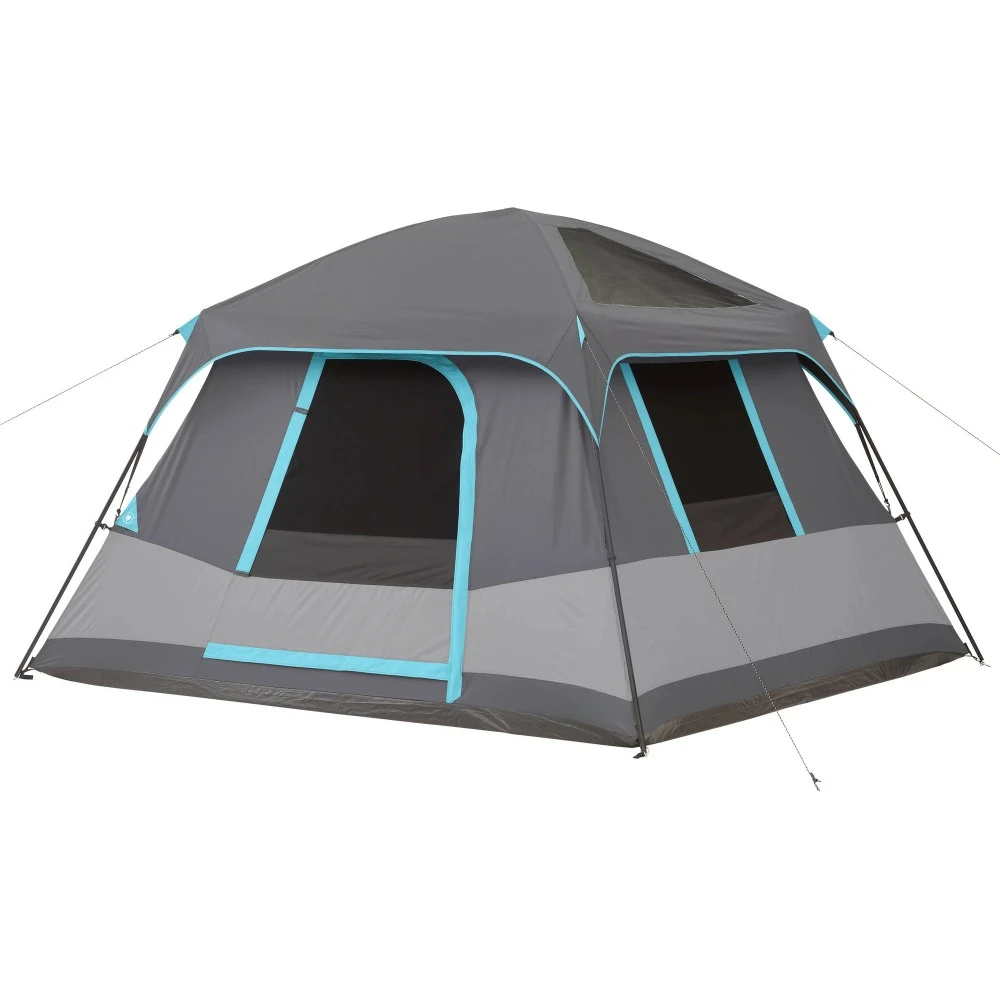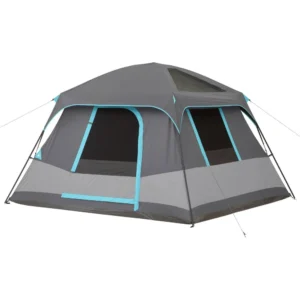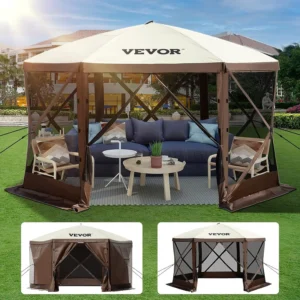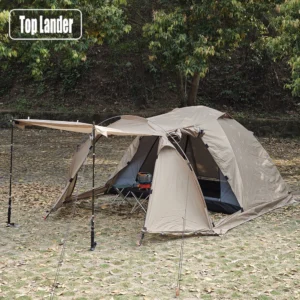Tall / Stand Up Camping Tent
Stand tall and camp comfortably: our tall stand-up tents give you room to move, change easily, and truly relax. Explore spacious shelters for your best outdoor trips.

Showing the single result
Tall / Stand Up Camping Tent, Two Room Camping Tent
$407.93 Select options This product has multiple variants. The options may be chosen on the product page
Showing the single result
Experience the Ultimate in Tall Camping Tents
Say goodbye to hunching over and hello to comfortable camping with Explore Elements’ collection of premium tall camping tents. These stand-up tents solve one of camping’s biggest frustrations by providing enough height for most adults to stand fully upright inside. No more crawling, crouching, or uncomfortable changing of clothes.
Our tall tents maintain the same quality standards as all our equipment—rigorously tested in conditions from scorching desert heat to heavy mountain snowfall. Each model delivers exceptional performance without sacrificing stability or weather protection.
In this category, you’ll discover camping shelters that transform your outdoor experience from merely surviving to truly thriving in nature, with designs that prioritize comfort without compromising on the rugged dependability you expect.
Why Height Matters in Your Camping Experience
The difference between an enjoyable camping trip and a frustrating one often comes down to a few extra inches of headroom. Standing height in a tent fundamentally transforms your outdoor living space in ways that impact every aspect of your camping experience:
- Easier daily activities: Changing clothes, getting organized, and moving around become effortless when you can stand straight
- Better circulation: Taller interiors allow warm air to rise, creating more comfortable sleeping conditions
- Reduced claustrophobia: The psychological impact of vertical space cannot be overstated—it creates a sense of openness even when weather forces you inside
- Practical comfort: From setting up sleeping arrangements to playing games during rainstorms, vertical space makes everything easier
Research consistently shows that adequate headroom ranks among the top factors influencing overall camping satisfaction. Most campers find that a minimum ceiling height of 6 feet (183 cm) dramatically improves comfort, allowing the tent to feel more like a temporary home than a restrictive shelter.
The vertical walls of stand-up tents also maximize usable floor space compared to dome camping tents, where sloping sides reduce the functional area. This means every square foot of your tent’s footprint remains usable from floor to ceiling.
Essential Features of Premium Stand-Up Tents
Quality tall tents combine several critical design elements to deliver both comfort and performance. Understanding these features helps you choose the right balance of space, stability, and weather protection.
Peak Height and Wall Design
Not all tall tents provide the same usable standing space. Consider these important design factors:
- Peak height measurement: This refers to the highest interior point, but doesn’t tell you how much standing area exists
- Wall angle: Near-vertical walls provide more usable standing space than steeply sloped ones
- Design comparison:
- Cabin designs offer the most standing room with almost vertical walls
- Tunnel tents provide good height along their center line
- Modified domes balance standing area with better stability in wind
The difference between a tent with 6’2″ (188 cm) peak height but steep walls and one with 6′ (183 cm) height but vertical walls can be dramatic in terms of usable space. The best designs create maximum standing area without compromising structural integrity.
Weather Protection and Durability
Tall tents must overcome unique challenges related to their increased surface area and height:
- Wind resistance: Taller structures catch more wind, requiring robust pole systems and strategic guying points
- Waterproofing: Larger rain flies must effectively channel water away from the tent body and entrances
- Seasonal rating: Three-season tall tents offer excellent balance for most campers, while four-season models add reinforcement for extreme conditions
- Condensation management: Taller interiors need proper ventilation to prevent moisture buildup, especially in cooler weather
Quality tall tents feature waterproof ratings of at least 1500mm hydrostatic head, with premium models offering 3000-5000mm for exceptional protection in prolonged rainfall. The best designs use materials like ripstop nylon with reinforced stress points and high-quality aluminum poles that flex without breaking.
Types of Stand-Up Tents for Different Adventures
Different camping styles demand different tall tent designs. Your ideal choice depends on factors including group size, camping location, transportation method, and expected weather conditions.
Family Camping Stand-Up Tents
Family-focused tall tents emphasize space, organization, and ease of use:
- Multi-room designs with removable dividers create private sleeping areas and common living spaces
- Multiple doors eliminate the need to climb over sleeping family members
- Blackout or dark room technology helps maintain healthy sleep schedules, especially with children
- Expansive windows and mesh panels improve airflow during warm weather
- Oversized storage pockets and gear lofts keep essentials organized
These designs prioritize livability over extreme portability, making them perfect for established campgrounds or base camping adventures where you stay in one location for several days.
Expedition and All-Season Tall Tents
For challenging conditions or year-round use, expedition-grade tall tents offer:
- Reinforced pole structures with additional crossing points for stability
- Four-season capability with convertible ventilation systems
- Snow-shedding designs to prevent dangerous accumulation
- Multiple guy-out points for securing the tent in high winds
- Robust materials that withstand UV exposure, abrasion, and temperature extremes
These specialized shelters command premium prices but deliver exceptional performance when weather conditions turn serious.
Setting Up Your Stand-Up Tent: Tips for Success
Tall tents require specific setup techniques to maximize stability:
- Select a level site large enough for both the tent and necessary guy lines
- Position the tent with the smallest profile facing prevailing winds
- Assemble the frame completely before attaching the tent body
- Stake corners firmly before raising the structure
- Use all provided guy lines, especially those supporting upper sections
- Adjust tension as needed after the tent settles
Proper setup makes a dramatic difference in how a tall tent performs, especially during windy conditions. Taking time to secure your shelter properly ensures both comfort and safety throughout your camping trip.
Is a Stand-Up Tent Right for Every Situation?
While tall tents excel in comfort, they aren’t ideal for all scenarios:
- Weight considerations: Stand-up tents typically weigh more than lightweight backpacking tents, making them better suited to car camping than long-distance hiking
- Wind exposure: Higher profiles catch more wind, requiring careful site selection in exposed areas
- Setup complexity: More poles and larger rainflies often mean longer setup times
- Space requirements: Larger footprints need more level ground, limiting site options in rugged terrain
For backpacking or alpine camping, the weight and wind-resistance tradeoffs may outweigh the comfort benefits of standing height. However, for most recreational camping situations, tall tents provide an excellent balance of livability and practical functionality.
Beyond the Basics: Enhancing Your Stand-Up Tent
Maximize your tall tent’s potential with these additions:
- Lighting solutions: Hanging lanterns or string lights make better use of vertical space than headlamps
- Organization systems: Hanging shelves and gear lofts utilize vertical space for storage
- Flooring options: Add interlocking foam tiles for insulation and comfort in larger tent spaces
- Extended vestibules: Additional covered outdoor space for gear storage and protected cooking
- Thermal insulation: For winter camping tents, supplemental floor insulation dramatically improves warmth
These enhancements transform your tall tent from simple shelter to comfortable backcountry accommodation, making extended camping trips more enjoyable for everyone.
Exploring Alternative Options
Stand-up tents represent one solution to camping comfort, but alternatives include:
- Two room camping tents when privacy matters more than ceiling height
- Instant camping tents with vertical walls when setup speed is your top priority
- Hybrid designs that incorporate partial standing height with lightweight construction
- Waterproof camping tents with lower profiles when challenging weather conditions are expected
Each option offers different advantages, and your ideal choice depends on balancing comfort priorities with practical considerations for your specific camping style and locations.




